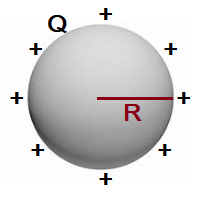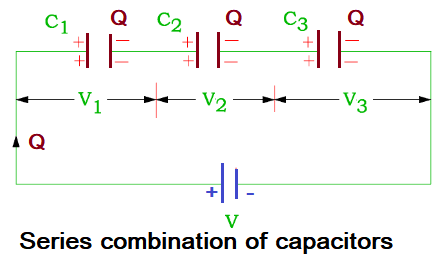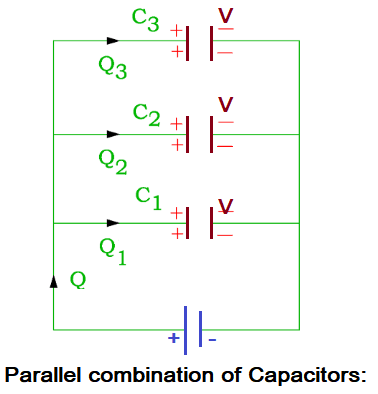Capacitors and Capacitance
Capacitors:
Capacitors are electronic devices that store electrical energy in an electric field. They are widely used in electronics and electrical systems for a variety of applications, such as energy storage, filtering, timing, and voltage regulation.
Capacitors consist of two conductive plates separated by a non-conductive material, called a dielectric. The dielectric material serves to increase the capacitance of the capacitor by reducing the electrical field strength between the plates.
Capacitance (C):
The ability of a conductor to store charge (electrical energy) is called capacitance. Capacitance is the property of a capacitor that determines how much electrical energy it can store.

It is measured as the ratio of the charge stored on the plates of the conductor/capacitor to the voltage across the plates.
Capacitance of a spherical conductor:

Consider a spherical conductor of radius R having charge Q and potential V.
Potential of spherical conductor V,

Using formula 

Capacitance of an isolated spherical conductor 
(i) If the medium surrounding the conductor have dielectric constant K.

Dielectric constant in terms of capacitance:

Dielectric constant is the ratio of capacitance of a conductor in a medium to the capacitance of conductor in vacuum.
Factors affecting capacitance of a conductor:
Capacitance of an isolated conductor depends on,
(a) Shape and size of the conductor : With increase in size of conductor, capacitance increases.
(b) Nature of surrounding medium : With increase in dielectric constant K on surrounding medium, capacitance increases.
(c) Presence of neighboring conductors : When a conductor is placed near a charged conductor, its capacitance increases.
Capacitance of a conductor does not depend on,
(a) Charge on the conductor
(b) Potential of the conductor
(c) Potential energy of the conductor
The capacitance of a conductor doesn’t depend on either the charge on the conductor or the potential of the conductor; it is measured in terms of the ratio of both.
Unit of Capacitance:
SI unit of Capacitance is farads (F), which is a very large unit of capacitance.


Capacitance of a conductor/capacitor is said to be 1 farad if it hold one coulomb of charge when a potential difference of one volt is applied across its terminals.
Practical unit of capacitance is pico-farad (pF), nano-farad (nF), or microfarad (µF).
1 pF = 10-12 F
1 nF = 10-9 F
1 µF = 10-6 F
Types of Capacitors:
- Capacitors can be classified into several types based on their construction, dielectric material, and application. Each type has its own unique properties, advantages, and limitations. Some of them are,
- Ceramic capacitors
- electrolytic capacitors
- paper / film capacitors
- variable capacitors
Use of Capacitors:
- Energy storage: Capacitors can store electrical energy and release it when needed. They are used in flash cameras, strobe lights, and other devices that require a burst of energy.
- Timing circuits: Capacitors can be used in combination with resistors to create timing circuits that generate precise time delays or oscillations. Such circuits are used in clocks, timers, and signal generators.
- Filter circuit: Capacitors can be used to filter out unwanted frequencies from a signal. They are commonly used in power supplies (used with rectifiers), audio circuits.
- Coupling: Capacitors can be used to pass AC signals from one stage of a circuit to another while blocking DC signals. This technique is called coupling and is used in amplifiers and other circuits.
- Voltage regulation: Capacitors can be used to regulate voltage in ac circuit.
- Power factor correction: Capacitors can improve the power factor of a circuit by supplying reactive power to cancel out the inductive reactive power of inductive loads. This technique is used in power factor correction circuits to improve efficiency and reduce energy costs.
Table of Contents

Combination of Capacitors
(1) Series combination of Capacitors:
In a series combination of capacitors, two or more capacitors are connected in such a way that the positive terminal of one capacitor is connected to the negative terminal of the next capacitor.

- When two or more capacitors are connected in series combination,
- Voltage across each capacitor is different, depending on its capacitance.
- Amount of charge on each capacitors is same.
Charge on each capacitors, using expression Q = C V
Q = C1 V1 = C2 V2 = C3 V3
V1 = Q / C1 V2 = Q / C2 V3 = Q / C3
Total potential, V = V1 + V2 + V3 = Q / C1 + Q / C2 + Q / C3 = Q ( 1 / C1 + 1 / C2 + 1 / C3 )
V / Q = ( 1 / C1 + 1 / C2 + 1 / C3 )
1 / C = ( 1 / C1 + 1 / C2 + 1 / C3 )
Equivalent capacitance of the combination, 
i.e. The reciprocal of the total capacitance of the combination of capacitors is equal to the sum of the reciprocals of each individual capacitance.
(2) Parallel combination of Capacitors:
In a parallel combination of capacitors, two or more capacitors are connected side by side such that each capacitor has its own connection to the positive and negative terminals of the circuit.

- When two or more capacitors are connected in parallel combination,
- The voltage across each capacitor is the same, and is equal to the voltage of the circuit.
- The total charge stored in the combination is divided among the individual capacitors according to their capacitance.
Charge on each capacitors, using expression Q = C V
Q1 = C1 V Q2 = C2 V Q3 = C3 V
From law of conservation of charge,
Q = CV = C1 V + C2 V + C3 V = V ( C1 + C2 + C3 )
Equivalent capacitance of the combination, C = C1 + C2 + C3
i.e. In a parallel combination of capacitors, the total capacitance of the combination is equal to the sum of the individual capacitances.
Important questions from Capacitors and Capacitance
What is net charge on Capacitors?
Answer: The net charge on a capacitor is zero, as both of its plates have an equal and opposite charge, and the positive charge on one plate cancels out the negative charge on the other plate.
It is important to note that the net charge on a capacitor can change when it is connected to a circuit or another capacitor. When capacitors are connected in series or parallel, the net charge on each capacitor can change, but the total charge in the system remains the same due to the law of conservation of charge.
In summary, the net charge on a capacitor is zero because the positive and negative charges on the plates cancel each other out. However, the net charge on a capacitor can change when it is connected to a circuit or other capacitors.
What is the capacitance of a capacitor and how is it measured?
Ans: The capacitance of a capacitor is a measure of its ability to store electrical charge. It is measured in farads (F) and is determined by the area of the plates, the distance between the plates, and the type of dielectric material used. Capacitance can be measured using a capacitance meter, an instrument that applies a known voltage to the capacitor and measures the resulting charge stored on its plates.
What is the dielectric material used in capacitors and why is it important?
Ans: The dielectric material used in capacitors is a non-conductive material that separates the two plates of the capacitor. It is important because it determines the capacitance of the capacitor and also affects its performance in terms of voltage rating, temperature stability, and frequency response. Common dielectric materials include ceramic, electrolytic, tantalum, polyester, and polypropylene.
IF net charge on capacitance is zero then how does it store energy?
In a capacitor, energy is stored in the electric field between two conductive plates separated by a dielectric material. When a voltage is applied to the capacitor, it causes the accumulation of charges of equal magnitude but opposite signs on the two plates. The electric field between the plates is proportional to the voltage and the distance between the plates, and the energy stored in the electric field is proportional to the square of the voltage.
Even though the net charge on a capacitor is zero, it still stores energy because the charges on the two plates are separated by a distance and create an electric field between them. The energy is stored in the electric field and is proportional to the square of the voltage across the capacitor.
When a capacitor is charged, it has a potential energy associated with it, and this energy is stored in the electric field between the plates. When the capacitor is discharged, the energy is released as the charges move back to their original positions. So, even though the net charge on the capacitor is zero, it still stores energy in the electric field between the plates.
What is the difference between a polarized and non-polarized capacitor?
Ans: A polarized capacitor has a positive and negative terminal and can only be connected in one direction in a circuit, whereas a non-polarized capacitor can be connected in either direction. Polarized capacitors are usually electrolytic capacitors, which have a higher capacitance value and are used in DC circuits, while non-polarized capacitors are usually ceramic or film capacitors, which have a lower capacitance value and are used in AC circuits.
What is the role of capacitors in power supplies?
Ans: Capacitors are used in power supplies to filter out unwanted noise and ripple in the DC voltage output. They act as energy storage devices, storing electrical energy from the rectified AC voltage and then releasing it slowly to smooth out the output voltage. Capacitors also help to protect the power supply from voltage spikes and surges.
How do capacitors store electrical energy?
A: Capacitors store electrical energy (U) in the form of an electric field between the plates. When a voltage is applied across the plates, electrons accumulate on one plate, creating a negative charge, and are removed from the other plate, creating a positive charge. The energy stored in the capacitor depends on the amount of charge stored in it and the voltage applied across it.

Can capacitors store an infinite amount of charge?
Ans: No, capacitors cannot store an infinite amount of charge. The amount of charge that can be stored on a capacitor is limited by its capacitance and the voltage applied across its plates. If the voltage exceeds the breakdown voltage of the dielectric material or the distance between the plates is too small, the capacitor may become damaged or the charges may “leak” through the dielectric material, reducing the amount of charge that can be stored.
How do you calculate the energy stored in a capacitor?
Ans: The energy stored in a capacitor can be calculated using the formula E=1 /2 CV2, where E is the energy in joules, C is the capacitance in farads, and V is the voltage across the plates in volts. This formula shows that the energy stored in a capacitor is proportional to the capacitance and the square of the voltage. It also demonstrates that doubling the voltage across the capacitor quadruples the energy stored.
Can two capacitors with the same capacitance have different energy storage capabilities?
Ans: Yes, two capacitors with the same capacitance can have different energy storage capabilities if they have different breakdown voltages or dielectric materials. The energy storage capability of a capacitor depends not only on its capacitance but also on the maximum voltage it can withstand before breaking down and the type of dielectric material used. Capacitors with a higher breakdown voltage or a more efficient dielectric material can store more energy than capacitors with a lower breakdown voltage or less efficient dielectric material.
How do temperature changes affect the capacitance of a capacitor?
Ans: Temperature changes can affect the capacitance of a capacitor by altering the dielectric constant of the dielectric material used. Most dielectric materials have a temperature coefficient of capacitance, which means that the capacitance changes with temperature. For example, as the temperature increases, the dielectric constant of some materials decreases, which causes the capacitance to decrease. Capacitors made with temperature-stable dielectric materials, such as ceramic capacitors, are less affected by temperature changes than capacitors made with less stable materials, such as electrolytic capacitors.
How do capacitors affect the frequency response of a circuit?
Ans: Capacitors can affect the frequency response of a circuit by acting as high-pass or low-pass filters. In high-pass filters, capacitors allow high-frequency signals to pass through while blocking low-frequency signals, while in low-pass filters, capacitors allow low-frequency signals to pass through while blocking high-frequency signals. The frequency response of a circuit can also be affected by the capacitance value of the capacitor. Higher capacitance values allow for a wider range of frequencies to pass through, while lower capacitance values only allow for a narrower range of frequencies.
How do capacitors differ from batteries in terms of energy storage?
Ans:
| Capacitor | Battery |
|---|---|
| Capacitor store energy in the form of electrical energy. | Battery store energy in the form of chemical energy. |
| Capacitors can store and release energy quickly | batteries store energy for a longer period of time |
| Capacitors are typically used in applications where fast energy transfer is required, such as in flash photography or as backup power supplies for electronic devices, | batteries are used in applications where long-term energy storage is necessary, such as in electric vehicles or portable devices |
Can capacitors be used to boost voltage in a circuit?
Ans: Yes, capacitors can be used to boost voltage in a circuit by storing energy and releasing it quickly when needed. When a capacitor is connected in series with a voltage source, it can be charged up to the voltage of the source. When the capacitor is disconnected from the source and connected to a load, the energy stored in the capacitor is released, boosting the voltage across the load. This effect is used in voltage multipliers, where capacitors are connected in a ladder configuration to produce a higher output voltage than the input voltage.
However, the amount of voltage that can be boosted by a capacitor is limited by the capacitance value and the amount of charge stored on the capacitor.
How do capacitors affect the power factor of a circuit?
Ans: Capacitors can improve the power factor of a circuit by supplying reactive power to the load. Reactive power is the power that is used to generate and sustain the electric and magnetic fields associated with inductive and capacitive loads. When capacitors are added to a circuit with inductive loads, they can supply the reactive power needed to cancel out the inductive reactive power, improving the overall power factor of the circuit. This effect is used in power factor correction circuits, where capacitors are connected in parallel with the inductive loads to improve the efficiency of the circuit and reduce energy costs.
However, care must be taken to ensure that the capacitance value is matched correctly to the inductance of the load to avoid overcompensation and other issues.
Q: What is a combination of capacitors?
A: A combination of capacitors refers to the arrangement of multiple capacitors in a circuit to achieve a desired capacitance or electrical behavior.
Q: How are capacitors combined in a circuit?
A: Capacitors can be combined in series or parallel in a circuit. In series, the capacitors are connected end to end, while in parallel, they are connected side by side.
Q: What is the equivalent capacitance of capacitors in series?
A: The equivalent capacitance of capacitors in series is given by the reciprocal of the sum of the reciprocals of their individual capacitances: 1/C_eq = 1/C_1 + 1/C_2 + … + 1/C_n
Q: What is the equivalent capacitance of capacitors in parallel?
A: The equivalent capacitance of capacitors in parallel is simply the sum of their individual capacitances: C_eq = C_1 + C_2 + … + C_n
Q: What is the effect of combining capacitors in series or parallel on the overall capacitance of a circuit?
A: Combining capacitors in parallel increases the overall capacitance of the circuit, while combining capacitors in series decreases the overall capacitance of the circuit.
Q: What is the application of combining capacitors in a circuit?
A: Combining capacitors can be used to achieve a desired capacitance value, to filter out unwanted noise, to stabilize power supplies, and in many other electronic circuits.
Q: Can capacitors be combined in both series and parallel in the same circuit?
A: Yes, capacitors can be combined in both series and parallel in the same circuit to achieve the desired capacitance and electrical behavior. This is known as a complex combination of capacitors.
MY YouTube Channel Link : 👉🖱 https://www.youtube.com/channel/UCGpC7nWE0-bBv9I53MM8qjQ
Capacitors and Capacitance, Capacitors and Capacitance, Capacitors and Capacitance, Capacitors and Capacitance, Capacitors and Capacitance, Capacitors and Capacitance, Capacitors and Capacitance, Capacitors and Capacitance, Capacitors and Capacitance, Capacitors and Capacitance, Capacitors and Capacitance, Capacitors and Capacitance,
Activities Supporting Speaking Skill Development
(Capacitors and Capacitance) Capacitors and Capacitance Capacitors and Capacitance Capacitors and Capacitance Capacitors and Capacitance Capacitors and Capacitance Capacitors and Capacitance Capacitors and Capacitance Capacitors and Capacitance Capacitors and Capacitance Capacitors and Capacitance Capacitors and Capacitance Capacitors and Capacitance Capacitors and Capacitance Capacitors and Capacitance Capacitors and Capacitance Capacitors and Capacitance Capacitors and Capacitance Capacitors and Capacitance Capacitors and Capacitance Capacitors and Capacitance